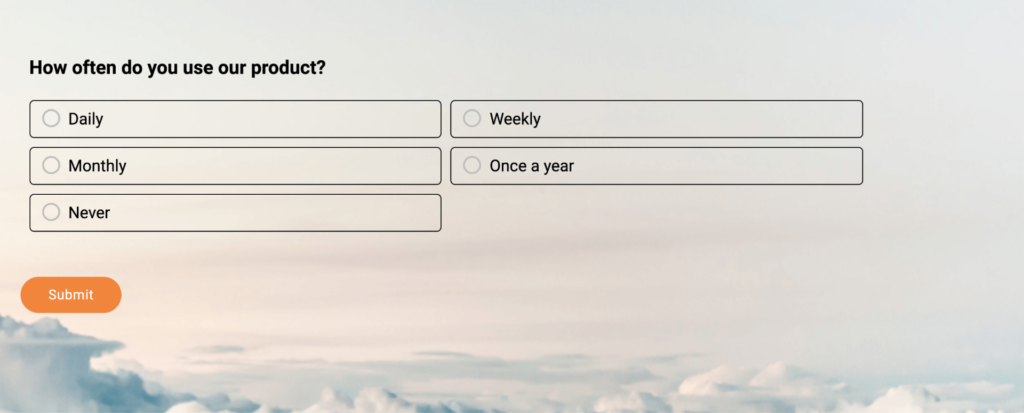
Ever wonder why your surveys aren’t giving you the data you need? You send out a bunch, but either they come back half-finished, or the answers don’t tell you anything useful.
It might be the questions that are the problem! As surprising as it sounds, there IS a right way of asking survey questions, and if done incorrectly, it will sabotage your survey data or may even fail to get any at all.
“There are no right answers to wrong questions.” – Ursula. K. Le Guin
In this blog, let’s look at the common survey questions that can mess up your results and how to avoid them to get better insights.
But first, for the ones unversed in the process of survey creation, here’s a quick video tutorial on how to create a survey for more context:
Watch: How to Create a Survey Using ProProfs Survey Maker
What Is a Bad Survey Question?
Bad survey questions fail to elicit useful, accurate, or honest participant responses. They often lead to confusion, misinterpretation, or biased answers that compromise the quality of the data collected.
| Bad Question: “Do you think our customer service is excellent?”
Good Question: “How would you rate our customer service?” |
Here are some common types of bad survey questions:
- Leading Questions: These suggest a particular answer or influence the respondent’s choice. For example, “Don’t you think our customer service is excellent?”
- Double-Barreled Questions: These ask about two different things in one question, making it hard to answer accurately. For example, “How satisfied are you with our product quality and customer service?”
- Ambiguous Questions: These are vague and can be interpreted in multiple ways. For example, “How often do you use our product?” without specifying a time frame (daily, weekly, etc.).
- Loaded Questions: These contain an assumption that might not be true for all respondents. For example, “Why do you prefer our product over others?”
- Negative Questions: These can confuse respondents because of the double-negative phrasing. For example, “Do you not disagree with the following statement?”
- Overly Complex Questions: These use complicated language or structure, making them hard to understand. For example, “What is your level of satisfaction with the timeliness and efficiency of our service delivery process?”
- Irrelevant Questions: These don’t relate to the survey’s main objective and can frustrate respondents. For example, asking for detailed demographic information when it’s not necessary for the study.
- Biased Options: These provide answer choices that are not balanced or comprehensive. For example, “How would you rate our product? (a) Excellent (b) Very Good (c) Good.”
- Jargon or Technical Terms: Using language that respondents may not understand can lead to confusion and inaccurate answers. For example, “What is your opinion on our product’s UX/UI?”
- Too Long or Too Many Questions: Lengthy surveys or too many questions can lead to survey fatigue, where respondents lose interest and provide less thoughtful answers or abandon the survey altogether.
What Are Some Examples of Bad Survey Questions?
Crafting a good survey is both an art and a science. While it’s tempting to think any question is a good question, certain types can lead to poor data quality, frustrated respondents, and ultimately useless insights.
Here are some common examples of bad survey questions, illustrated with vivid examples and explanations:
1. Leading Questions
Leading questions suggest a particular answer and can bias your results. They subtly (or not so subtly) push respondents towards a specific response.
Example: “Don’t you think our customer service is excellent?”
Why It’s Bad: This question implies that the respondent should think the customer service is excellent. A more neutral way to ask would be, “How would you rate our customer service?”

2. Double-Barreled Questions
These questions ask about two different things simultaneously, making it impossible for respondents to provide a clear answer.
Example: “How satisfied are you with our product quality and customer service?”
Why It’s Bad: The respondent might have different opinions about product quality and customer service. Split this into two separate questions for clarity.
3. Ambiguous Questions
Ambiguous questions are vague and open to multiple interpretations, leading to inconsistent and unreliable data.
Example: “Do you use our product frequently?”
Why It’s Bad: Without specifying a time frame (daily, weekly, monthly), responses can vary wildly. Clarify the period to get more accurate data, like “How often do you use our product?”

4. Loaded Questions
Loaded questions contain assumptions that might not be true for all respondents, putting them in a difficult position.
Example: “Why do you prefer our product over others?”
Why It’s Bad: This assumes the respondent prefers your product, which might not be the case. A better approach would be, “Do you prefer our product over others? Why or why not?”
5. Negative Questions
Negative questions can confuse respondents, especially if they contain double negatives.
Example: “Do you not disagree with the following statement?”
Why It’s Bad: This is confusing. Instead, use positive framing like, “Do you agree with the following statement? Yes/No”
6. Overly Complex Questions
Complex questions with convoluted language or structure can be hard for respondents to understand.
Example: “What is your level of satisfaction with the timeliness and efficiency of our service delivery process?”
Why It’s Bad: Simplify it to “How satisfied are you with the speed of our service?” and “How satisfied are you with the efficiency of our service?”
7. Irrelevant Questions
Questions that don’t relate to the survey’s main objective can frustrate respondents and lead to higher dropout rates.
Example: Asking for detailed demographic information when it’s irrelevant to the survey’s purpose.
Why It’s Bad: Only ask for necessary information directly related to your survey goals.
8. Biased Options
Answer choices that are not balanced or comprehensive can skew your data.
Example: “How would you rate our product? (a) Excellent (b) Very Good (c) Good.”
Why It’s Bad: There are no negative options, forcing respondents to give a positive answer. Include a range like “(a) Excellent (b) Good (c) Fair (d) Poor.”
9. Jargon or Technical Terms
Using industry jargon or technical terms can confuse respondents who aren’t familiar with the terminology.
Example: “What is your opinion on our product’s UX/UI?”
Why It’s Bad: Not everyone knows what UX/UI means. Instead, ask, “What do you think of our product’s design and ease of use?”
10. Too Long or Too Many Questions
Would you want to complete a survey that feels like a marathon? Probably not. Surveys that are too lengthy or ask too many questions can lead to survey fatigue, which causes respondents to rush through or abandon the survey altogether.
Example: A survey that goes on for pages and pages with repetitive or overly detailed questions.
Why It’s Bad: Keep surveys concise and focused. If it’s too long, respondents may give less thoughtful answers or drop out before finishing.
| Looking to create a well-balanced survey?
Try ProProfs AI Survey Generator or use our Readymade Survey Templates |
What Are the Consequences of Bad Survey Questions?
Creating a survey may seem straightforward, but the quality of your questions can make or break the reliability of your data. Bad survey questions don’t just irritate your respondents—they can also lead to a cascade of negative consequences that undermine your research efforts.
Here’s what can happen if your survey questions miss the mark:
1. Misleading Data
Imagine you’ve spent weeks gathering survey responses only to find out the data doesn’t really reflect the truth. Leading questions, like “Don’t you think our product is amazing?,” can push respondents towards a particular answer. This skews your results and paints a rosier picture than reality.
Impact: You might believe your product is a hit when it needs improvements. This false confidence can lead to strategic missteps and missed opportunities for growth.
2. Low Response Rates
Complex or overly long surveys are like mazes with no exits. Questions filled with jargon or asking for too much detail can discourage participants from completing the survey.
Impact: Low response rates make it difficult to get a clear picture of your audience’s opinions. You might have to send out more surveys or accept that your data isn’t representative of your target group.
3. Incomplete Responses
Double-barreled questions like “How satisfied are you with our product quality and customer service?” can confuse respondents. If they have different opinions on each part, they may not know how to answer.
Impact: This leads to incomplete responses, making data analysis a headache. You’re left piecing together partial answers, which can dilute the insights you’re aiming to gain.
4. Biased Results
Questions that carry an inherent bias, such as “Why do you prefer our service over others?”, can skew your data. They assume a positive response, which might not be the case for everyone.
Impact: Biased results can lead you down the wrong path, making you think you’re doing better than you are. This can prevent you from addressing real issues that need attention.
5. Frustrated Respondents
Confusing or irrelevant questions can frustrate your audience. Imagine being asked a question that makes no sense or doesn’t apply to you – it’s annoying!
Impact: Frustrated respondents are likely to abandon the survey or provide less thoughtful answers. Worse, they might develop a negative view of your brand, impacting their future interactions with you.
6. Invalid Comparisons
Vague questions like “How often do you use our product?” can lead to varied interpretations without specifying a time frame. One person might think daily, another weekly.
Impact: This variability makes it hard to compare responses across different groups or time periods. You might miss out on spotting trends or patterns that are crucial for strategic decisions.
7. Wasted Resources
Conducting surveys is an investment of time and money. Poorly designed surveys that need to be redone are a drain on both.
Impact: Wasted resources mean higher costs and longer timelines for obtaining the data you need. This inefficiency can slow down your decision-making processes.
8. Misinterpreted Feedback
Ambiguous questions can lead to misunderstandings. If respondents are unclear about what you’re asking, their answers won’t be useful.
Impact: Misinterpreted feedback can lead you to make changes based on incorrect assumptions, potentially harming your product or service rather than improving it.
9. Survey Fatigue
Lengthy surveys filled with repetitive or irrelevant questions can tire out respondents. By the end, they might just be clicking through to finish as quickly as possible.
Impact: Survey fatigue results in lower-quality data, as tired respondents are less likely to provide thoughtful and accurate answers. This diminishes the value of the insights you gather.
10. Damage to Reputation
If your surveys consistently feature poor questions, people will start to associate your brand with confusion and frustration.
Impact: A tarnished reputation makes future surveys less effective. People will be less willing to participate, fearing another bad experience, which reduces your ability to collect valuable feedback.
How to Avoid Bad Survey Questions: Best Practices
Let’s look at some best practices to help you avoid bad survey questions and design surveys that yield accurate and useful responses:
Step into Your Respondent’s Shoes
Before you start typing, take a moment to consider the person answering your questions. What’s their level of understanding about your topic? Are they familiar with any technical terms you might use? Put yourself in their shoes and aim for clear, concise language that anyone can grasp.
Focus on One Thought at a Time
Double-barreled questions, the ones that ask two things at once, are a recipe for disaster. Imagine asking someone, “How satisfied are you with the price and quality of our product?” They might love the quality but hate the price, or vice versa! Instead, break it down: “How satisfied are you with the price of our product?” and “How satisfied are you with the quality of our product?”
Avoid Leading Language
Leading questions sneakily push respondents towards a specific answer. For example, “Don’t you think our customer service is excellent?” Instead, be neutral. Ask something like, “How would you rate your recent experience with our customer service?”
Offer a Spectrum of Answers
Multiple-choice questions are great, but make sure your answer options are clear and cover the full range of possibilities. Don’t force respondents to choose between “Good” and “Excellent” if they feel their experience was just “Okay.” Include options like “Neutral” or “Needs Improvement” to capture a wider range of feedback.
Include Open-Ended Questions
Open-ended questions can be goldmines for in-depth feedback. But don’t just ask, “What are your thoughts?” Guide them a little. For example, “What did you find most helpful about our recent webinar?” or “What could we do to improve your overall experience with our brand?”
Test, Refine, Repeat
Don’t release your survey before a little quality control. Run a pilot test with a small group and see how your questions land. Are they clear? Do they generate the kind of data you’re looking for? Refine them based on the feedback, and watch your response rates (and data quality) soar!
FREE. All Features. FOREVER!
Try our Forever FREE account with all premium features!
Create the Perfect Survey to Mine Valuable Insights
Watch: How to Choose the Best Survey Software
As much as surveys are popular, they can be equally difficult to perfect if you don’t learn the art of asking the right questions. The good news is, crafting effective surveys is an achievable skill. By understanding the pitfalls of bad survey questions and adopting best practices, you can create surveys that are clear, unbiased, and engaging.
With the steps mentioned in the blog, your surveys will transform from frustrating questionnaires to clear communication channels. But for that, choosing a good survey software that will guide you in the requisite direction even without prior experience is crucial.
To know more, sign up for free or get a demo.
Happy surveying, and may the data you gather be ever insightful!
FREE. All Features. FOREVER!
Try our Forever FREE account with all premium features!
 We'd love your feedback!
We'd love your feedback!
 Thanks for your feedback!
Thanks for your feedback!






